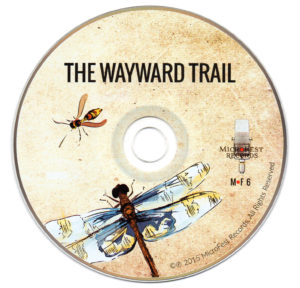The Wayward Trail – Notes
Track List
1. 15 Zwiefache Transzendiert (1977-81) – [7:40] – Walter Zimmermann
Steel Suite (2003-2008) – [16:41] – David B. Doty
2. Prelude (tastar de corde) – 6:04
3. Balkan Dance – 3:56
4. A New Waltz in Pelog – 4:10
5. Gigue (Maggie’s Jigs) – 2:31
Songs and Toods (2005) – [27:49] – Larry Polansky
6. Schneidertood – 1:40
7. Dismission of Great I – 3:04
8. Sweet Betsy from Pike – 8:11
9. Eskimo Lullaby – 5:10
10. 85 Chords – 9:44
11. Forward (2014) – [13:58] – Ezequiel Menalled
Elliot Simpson – Nationa Reso-Phonic Just Intonation Tricone guitar
Notes
Eighty-five years ago in New Orleans, a young American composer by the name of Harry Partch inaugurated a new stage in his musical journey by modifying a viola to play in just intonation and burning a pile of his compositions (some, including Partch, say all of them) in a pot-bellied stove. With this pair of creative and destructive actions Partch completed his renunciation of common-practice European principles of harmony, prosody, and form in favor of a new aesthetic based on pure intonation, clear and intelligible text-setting, and an emphasis on the “Corporeal” aspects of music-making. Over the following decades Partch continued to develop and refine his compositional world—which he would call Monophony—adapting and constructing an original assembly of instruments tuned to satisfy his precise intonational requirements. He would look outwards to musical cultures of other places and times, drawing from the aesthetics of Japanese Noh theater and from ancient Greek and Chinese tuning theories; and he would look inwards, reflecting on his experiences living as a transient at the height of the Great Depression, and incorporating fragments, stories, and characters from the road in compositions such as Barstow, U.S. Highball, and his journal-with-musical-settings Bitter Music. Partially in reference to the “outsider” quality of his artistic formation and life experience, Partch would come to refer to his complex stylistic development as a “wayward trail.”
 Several other American musicians, of course, have abandoned the mainstream and struck off on their own; some of them also happened to cross paths with Harry. In 1947 one composer underwent a severe crisis: Lou Harrison had not adapted well to life in bustling New York City, where a combination of personal, environmental, and professional stresses triggered a nervous breakdown. As part of his recovery, Harrison interpreted a “family history” project suggested by his therapist to include a retracing of his musical family tree back to the earliest theoretical texts he could find. In 1949, Virgil Thomson presented Harrison with a newly published book on similar topics; this text, Partch’s Genesis of a Music, ultimately prompted Harrison to incorporate rational tunings and instrument-making into his renewed compositional style.
Several other American musicians, of course, have abandoned the mainstream and struck off on their own; some of them also happened to cross paths with Harry. In 1947 one composer underwent a severe crisis: Lou Harrison had not adapted well to life in bustling New York City, where a combination of personal, environmental, and professional stresses triggered a nervous breakdown. As part of his recovery, Harrison interpreted a “family history” project suggested by his therapist to include a retracing of his musical family tree back to the earliest theoretical texts he could find. In 1949, Virgil Thomson presented Harrison with a newly published book on similar topics; this text, Partch’s Genesis of a Music, ultimately prompted Harrison to incorporate rational tunings and instrument-making into his renewed compositional style.
Towards the end of his life, Harrison responded to a commission by the Other Minds Festival by composing a three-movement piece, Scenes from Nek Chand, for a metal-bodied resophonic guitar capable of producing just intervals. This unique instrument was brought to life thanks to the combined efforts of guitarist John Schneider, composer/theorist Bill Alves, Harrison’s assistant Bill Slye, and the National Reso-Phonic guitar company (who between 2003 and 2005 minted five copies of the design, one of which appears on this recording). In the intervening years the just intonation resophonic guitar has struck the imagination of younger generations of composers and performers, effectively bringing the legacy of Partch’s experimentalism into the twenty-first century.
The guitar is tuned to a just intonation scale built on a hypothetical low G (a perfect fifth below the pitch of its lowest string), incorporating ratios derived from up to the eleventh partial. In its default DADGAD open string tuning the guitar offers rich 11-limit harmonic collections on G and D fundamentals; as we will see, more complex intervals can be incorporated through further modification of the open string configuration. The resophonic guitar’s three resonating cones, metal-body construction, and newly implemented rational tuning combine to produce a glowing sound, yielding greater volume, sustain, and harmonic complexity than conventional steel- or nylon-string guitars.
All compositions on this record relate with the aesthetic paradigms of Partch and Harrison in various ways. All four pieces confront (and often transcend) the challenges inherent in employing rational tunings on fretted instruments. Three of the works were composed specifically for the just intonation resophonic guitar; the instrument’s enhanced brilliance and sustain also suits the frail harmonic texture of the fourth (Zimmerman’s 15 Zwiefache, composed over twenty years before these developments). Some of the pieces (Polansky’s toods, Menalled’s Forward) approach the guitar from a theoretically aggressive angle, fiddling with the original tuning and almost “breaking” the fingerboard; others explore the integration of folk materials, from viewpoints both within (Polansky, Zimmermann) and outside (Doty) the sources.
 Zimmermann’s 15 Zwiefache was written as part of a cycle of pieces expressing the composer’s response to his encounters with American experimental music. In 1975 Zimmermann took to the United States and completed a series of interviews with several composers in the U.S. experimental “working tradition,” following paths that led him to figures who were not necessarily well-known (and definitely not entirely understood) in Europe at the time, such as Philip Corner, James Tenney, and Ben Johnston. Zimmermann could not interview Partch, who had died the year before; however, encountering his ideas through the viewpoint of people who had worked with him (Tenney, Johnston), Zimmermann came to identify Partch as a central figure in this group of so called “Desert Plants”—creative organisms who managed to flourish despite adverse and isolated conditions. The published collection of interviews, which bears the same name, was dedicated to him, and closes with Johnston’s discussion of Partch’s artistic world.
Zimmermann’s 15 Zwiefache was written as part of a cycle of pieces expressing the composer’s response to his encounters with American experimental music. In 1975 Zimmermann took to the United States and completed a series of interviews with several composers in the U.S. experimental “working tradition,” following paths that led him to figures who were not necessarily well-known (and definitely not entirely understood) in Europe at the time, such as Philip Corner, James Tenney, and Ben Johnston. Zimmermann could not interview Partch, who had died the year before; however, encountering his ideas through the viewpoint of people who had worked with him (Tenney, Johnston), Zimmermann came to identify Partch as a central figure in this group of so called “Desert Plants”—creative organisms who managed to flourish despite adverse and isolated conditions. The published collection of interviews, which bears the same name, was dedicated to him, and closes with Johnston’s discussion of Partch’s artistic world.
From a strictly creative standpoint, however, Zimmermann was especially influenced by Corner’s suggestion to consider his immediate musical surroundings as a source of inspiration. Upon returning to Germany Zimmermann turned to the traditional music of his native Franconia, eventually completing a cycle of works for various combinations of instruments entitled Lokale Musik. 15 Zwiefache explores the alternating duple and triple meters of the titular dance in an ethereal texture consisting entirely of natural harmonics, where pitch and duration are transformed. Simultaneously sublime and earthy, this is music that transcends the materials on which it is based without indulging in any sort of drama—perhaps coming closer to the aesthetics of Cage than those of Partch in the process.
Partch and Harrison represent two fundamental pillars in the development of David Doty’s style, who encountered the writings and music of the former in 1970s, and was definitely “converted” to writing music in rational tunings after performing on the latter’s American Gamelan instruments in 1975. Doty was among the first composers to respond to Harrison’s justly-tuned resophonic guitar, composing a four-movement suite for guitarist John Schneider between 2003 and 2008.
The Steel Suite incorporates Renaissance and Baroque forms (most overtly in the ricercare-like fashion of the opening “Prelude” and in the frequent binary structures), as well as the rhythmic and melodic features of folk and non-Western musics, such as the additive groupings of the “Balkan Dance,” or the changing modal subsets of the “Waltz in Pelog,” which evokes the family of Javanese gamelan tunings. The four movements explore contrasting regions of the instrument’s intonation, creating changing atmospheres as they move from the largely septimal sonorities of the opening, through the undecimal punctuation of the second, to the more exotic modal flavors of the third, and finally to the glowing triadic consonance of the last. The music’s dense contrapuntal independence and quick pace make this suite a thoroughly challenging work for the performer; this recording represents its first complete performance on the guitar (an arrangement for harpsichord was done in part to obviate some of the piece’s difficulties through the employment of an extra set of fingers).
Like Doty’s Suite, Larry Polansky’s Songs and Toods dates back from the years immediately following the creation of the just intonation resophonic guitar. The work consists of five independent pieces, three of which require the guitarist to sing, while the remaining two deal with more strictly theoretical concerns in the guise of modernistic etudes (hence Polansky’s neologysm in the title). Each of the pieces tunes the guitar differently, with the setting of “Sweet Betsy from Pike” as the only one to maintain the original tuning. This decision is partially programmatic: the movement is dedicated to the memory of Lou Harrison and his partner Bill Colvig, a couple who found their happiness in California much like the protagonists of the tune. Like most settings of vernacular music by Polansky, the melodic line is left untouched, whereas the accompaniment is manipulated to create a virtuosic musical stream that is often independent from the voice.
In “Eskimo Lullaby,” an almost-literal transcription of a nineteenth century harmonization found in the collection Folk Songs of Canada, the tuning’s original fundamental is revealed by retuning the lowest string of the guitar down to an extremely low and floppy G. As opposed to the other songs in the collection, this gentle lullaby features a largely homophonic and consonant accompaniment, resulting in a significantly less intimidating challenge for the performer. “Dismission of Great I,” on the other hand, juxtaposes the diatonic Shaker melody with a polytonal and rhythmically independent guitar part. The diaphonic effect is exacerbated by the tweaked tuning system, which pitches two of the strings only a few cents apart to create shimmering, beating passages.
The two toods, as mentioned, approach the guitar as a sandbox for intonation experiments. “85 Chords,” which is nicknamed “The Historical Tuning Problem,” traces an arc from consonance to maximum intervallic complexity, generated by an algorithm that combines Euler’s Gradus Suavitatis function with a model of the instrument’s yet-again-modified tuning. The program attempts to keep as many common tones from one chord to the next, and in this recording these sustaining voices are emphasized by a combination of electronic “hold” effects and an accompanying trumpet line. The guitar’s tuning is ultimately deconstructed in “Schneidertood,” a piece belonging to a series of works (nicknamed “onceatoods”) that systematically explore the range of available pitches on an instrument. Here the guitar is retuned so that each of the twelve “pitch classes” actually results in a series of slight microtonal shades across the six strings; each of these unique cognates is sounded only once, gradually giving way to the frenetic, “noisy” accompanying texture.
Ezequiel Menalled’s Forward is the newest piece in this collection, having been completed just a few weeks before the recording sessions, and representing the approach and perspective of a composer two generations younger than the rest. There are no folk allusions here, and the instrument’s tonal leanings (which are more or less built in with lower harmonic just intonation systems) are disrupted by tampering with the tuning of the open strings. In addition to raising the third string from G (4:3) to G# (11:8), the lowest string is retuned to C, transposed several octaves below its occurrence as the seventh harmonic of the instrument’s D. The first string is also retuned to E, this time as the fifth harmonic (major third) of the low C, thus splitting the guitar in two separate tonal planes. Though technically both of these notes are harmonically related to the fundamental D, the psychoacoustic effect of not having the fundamental as the lowest note is too strong to ignore. The resulting sonority of the instrument is made all the more nebulous and mysterious by the resulting (and sometimes conflicting) harmonics.
The piece unfolds as sectional explorations of various aspects of the instrument’s resonance, timbre, and the many microtonal shadings afforded by the modified tuning. Pitch originally emerges from noise, as the muffled strings are gradually released and allowed to vibrate. The ensuing sections grow increasingly complex in rhythm and texture, as up to four voices articulate temporal soundings of the harmonic material; electronic parts (generated from the recorded sound of the guitar itself) provide additional resonant support. This sonic journey exhausts itself in a manner similar to the opening, as once again pitched sounds give way to more indeterminate sonorities, found in this case in the portions of “dead” string behind the nut and between tailpiece and bridge. The instrument as a whole has thus become the subject (and object) of extensive sonorous examination, generating an abstract soundscape in which the listener is invited to explore, wander, and wonder.
-Giacomo Fiore
Text
Dismission of Great I
Go off, Great I, and come not nigh,
and quit my habitation.
And come no more, within my door,
corrupting my sensation.
Depart I say, flee far away,
your ways no more I’ll practice.
For those who try to be Great I,
are vicious, proud and fractious.
Sweet Betsy From Pike
O don’t you remember sweet Betsy from Pike
Who crossed the wide prairies with her lover Ike,
With two yoke of cattle and one spotted hog
A tall shanghai rooster and an old yeller dog?
The shanghai ran off and the cattle all died;
The last piece of bacon that morning was fried.
Poor Ike got discouraged and Betsy got mad,
And the dog wagged his tail and looked wonderful sad.
The alkali desert was burning and bare,
And Isaac’s soul shrank from the death that was there;
“Dear old Pike County, I’ll go back to you”
Said Betsy “You’ll go by yourself if you do.”
They soon reached the desert where Betsy gave out,
And down in the sand she lay rolling about;
When Ike in great terror looked on in surprise,
Saying, “Betsy, get up you’ll get sand in your eyes.”
Sweet Betsy got up in a great deal of pain.
And declared she’d go back to Pike County again;
Then Ike heaved a sigh and they fondly embraced
And she traveled along with his arm round her waist.
They swam the wide rivers and crossed the tall peaks
And camped on the prairies for weeks upon weeks,
Starvation and cholera and hard work and slaughter
They reached California spite of hell and high water.
One morning they climbed up a very high hill,
And with wonder looked down on old Placerville;
Ike shouted and said, as he cast his eyes down,
“Sweet Betsy, my darling, we’ve got to Hongtown.”
Long Ike and sweet Betsy attended a dance,
Where Ike wore a pair of his Pike County pants,
Sweet Betsy was covered with ribbons and rings,
Quote Ike “You’re an angel, but where are your wings?”
Eskimo Lullaby
Still now, and hear my singing.
Sleep through the night, my darling.
We have a tiny daughter.
Thanks be to god, who sent her.
The Artist
Guitarist Elliot Simpson has given premieres of works by such iconic and diverse composers as Sofia Gubaidulina, Alvin Lucier, and Michael Finnissy, and has collaborated with many acclaimed young composers including Hugo Morales, Ezequiel Menalled, Benjamin Staern, and Sahba Aminikia. He has been a guest of organizations including the Asko|Schönberg Ensemble, the San Francisco Symphony, the New European Ensemble, the György Ligeti Academy, and the Verband für aktuelle Musik Hamburg, as well as festivals and concert series throughout the United States and Europe in performances ranging from early music to free improvisation. He is a member of the contemporary music group Ensemble Modelo62 and, in the 2013/2014 season, will also perform and record as soloist with the Asko|Schönberg Ensemble under the direction of Reinbert de Leeuw. Awards include prizes at the international competitions of Zwolle (NL) and Nordhorn (DE), and the prestigious Huygens Grant from the Netherlands Ministry of Education, Culture and Science.
Originally from New Mexico, USA, Elliot studied with David Tanenbaum at the San Francisco Conservatory of Music and with Zoran Dukic at the Royal Conservatoire of The Hague. His Master’s degree in The Hague, as both soloist and chamber musician, was awarded “with distinction for his extraordinary contribution to new music.”
He lives and teaches privately in The Hague.
Recording
Recorded October 10-12, 2014 in the chapel of the Kapucijnenklooster Emmaus, Velp, NL
Executive Producer: John Schneider
Producer: Ezequiel Menalled and Elliot Simpson
Recording Engineer: Dario Giustarini
Mastering Engineer: Scott Fraser, Architecture
Artwork and Design: Fonda Carranza
Photography: Santiago Lascurain
Trumpet on 85 Chords: Justin Christensen
Guitar: National Reso-Phonic Just Intonation Tricone, 2005, #004
Steel Suite published by Pilker Music, BMI
Forward commissioned with financial support from the Performing Arts Fund NL
Made possible with support from the Stichting ter Exploitatie van Naburige Rechten
℗©2015 MicroFest Records, all rights reserved
P.O. Box 237, Pasadena, CA 91102





